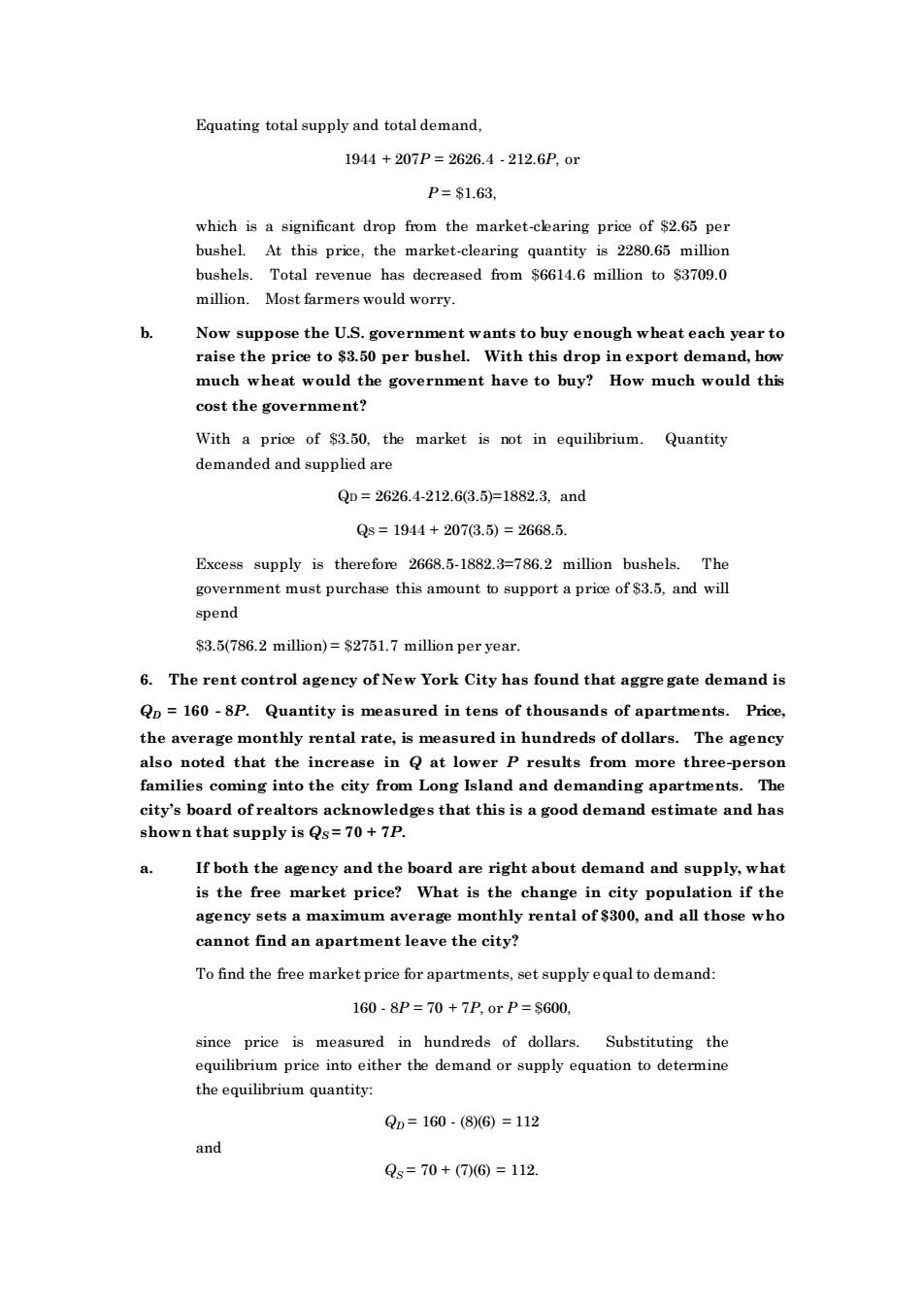正在加载图片...

Equating total supply and total demand. 1944+207P=2626.4-212.GP0r P=$1.63 which is a significant drop from the market-ckearing price of $265 per bushel.At this price,the market-clearing quantity i82280.65mii bushels Total revenue has decreased from $6614.6 million to $3709. million.Most farmers would worry. Now suppose the U.S.government wants to buy enough wheat each year to raise the price to $3.50 per bushel.With this drop in export demand,how much wheat would the government have to buy?How much would this cost the government? With a price of $3.50,the market is not in equilibrium Quantity demanded and supplied are QD=2626.4-212.63.5=1882.3and Qs=1944+2073.5)=2668.5 Excess supply is therefore 2668.5-1882.3=786.2 million bushels.The government must purchase this amount to support a price of $3.5,and will spend $3.5(786.2 million)=$2751.7 million per year. 6.The rent control agency of New York City has found that aggregate demand is Qp =160-8P.Quantity is measured in tens of thousands of apartments.Price, the average nthly rental rate,is measured in hundreds of dollars.The agency noted I tha in Q at lower P resu s from more three-pers s coming into the city from Long Island and demanding apartments.The city's board of realtors acknowledges that this is a good demand estimate and has shown that supply is Qs=70+7P. If both the agency and the board are right about demand and supply,what is the free pulation if the age ets。 rental of $300. cannot find an apartment leave the city? To find the free market price for apartments,set supply equal to demand 160-8P=70+7P,orP=$60, since price is measured in hundreds of dollars.Substituting the equilibrium price into either the demand or supply equation to determine the equilibrium quantity: QD=160-(86)=112 and Qs=70+(⑦)6)=112. Equating total supply and total demand, 1944 + 207P = 2626.4 - 212.6P, or P = $1.63, which is a significant drop from the market-clearing price of $2.65 per bushel. At this price, the market-clearing quantity is 2280.65 million bushels. Total revenue has decreased from $6614.6 million to $3709.0 million. Most farmers would worry. b. Now suppose the U.S. government wants to buy enough wheat each year to raise the price to $3.50 per bushel. With this drop in export demand, how much wheat would the government have to buy? How much would this cost the government? With a price of $3.50, the market is not in equilibrium. Quantity demanded and supplied are QD = 2626.4-212.6(3.5)=1882.3, and QS = 1944 + 207(3.5) = 2668.5. Excess supply is therefore 2668.5-1882.3=786.2 million bushels. The government must purchase this amount to support a price of $3.5, and will spend $3.5(786.2 million) = $2751.7 million per year. 6. The rent control agency of New York City has found that aggregate demand is QD = 160 - 8P. Quantity is measured in tens of thousands of apartments. Price, the average monthly rental rate, is measured in hundreds of dollars. The agency also noted that the increase in Q at lower P results from more three-person families coming into the city from Long Island and demanding apartments. The city’s board of realtors acknowledges that this is a good demand estimate and has shown that supply is QS = 70 + 7P. a. If both the agency and the board are right about demand and supply, what is the free market price? What is the change in city population if the agency sets a maximum average monthly rental of $300, and all those who cannot find an apartment leave the city? To find the free market price for apartments, set supply equal to demand: 160 - 8P = 70 + 7P, or P = $600, since price is measured in hundreds of dollars. Substituting the equilibrium price into either the demand or supply equation to determine the equilibrium quantity: QD = 160 - (8)(6) = 112 and QS = 70 + (7)(6) = 112